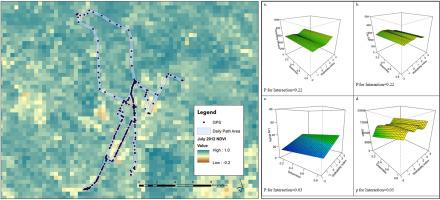Environment International ( IF 10.3 ) Pub Date : 2022-05-23 , DOI: 10.1016/j.envint.2022.107317 Oriol Marquet 1 , Jana A Hirsch 2 , Jacqueline Kerr 3 , Marta M Jankowska 4 , Jonathan Mitchell 5 , Jaime E Hart 6 , Francine Laden 6 , J Aaron Hipp 7 , Peter James 8

|
Introduction
Built and natural environments may provide opportunities for physical activity. However, studies are limited by primarily using residential addresses to define exposure and self-report to measure physical activity. We quantified associations between global positioning systems (GPS)-based activity space measures of environmental exposure and accelerometer-based physical activity.
Methods
Using a nationwide sample of working female adults (N = 354), we obtained seven days of GPS and accelerometry data. We created Daily Path Area activity spaces using GPS data and linked these activity spaces to spatial datasets on walkability (EPA Smart Location Database at the Census block group level) and greenness (satellite vegetation at 250 m resolution). We utilized generalized additive models to examine nonlinear associations between activity space exposures and accelerometer-derived physical activity outcomes adjusted for demographic characteristics, socioeconomic factors, and self-rated health.
Results
Higher activity space walkability was associated with higher levels of moderate-vigorous physical activity, and higher activity space greenness was associated with greater numbers of steps per week. No strong relationships were observed for sedentary behavior or light physical activity. Highest levels of moderate-vigorous physical activity were observed for participants with both high walkability and high greenness in their activity spaces.
Conclusion
This study contributes evidence that higher levels of physical activity occur in environments with more dense, diverse, and well-connected built environments, and with higher amounts of vegetation. These data suggest that urban planners, landscape architects, and policy makers should implement and evaluate environmental interventions to encourage higher levels of physical activity.
中文翻译:

基于 GPS 的活动空间暴露在绿色和步行环境中与基于加速度计的身体活动增加有关
介绍
建筑和自然环境可能会提供身体活动的机会。然而,研究的局限性在于主要使用居住地址来定义暴露和自我报告来测量身体活动。我们量化了基于全球定位系统 (GPS) 的环境暴露活动空间测量与基于加速度计的身体活动之间的关联。
方法
使用全国范围内的职业女性成年人样本 (N = 354),我们获得了 7 天的 GPS 和加速度计数据。我们使用 GPS 数据创建了 Daily Path Area 活动空间,并将这些活动空间链接到关于可步行性(人口普查区块组级别的 EPA 智能位置数据库)和绿色(250 米分辨率的卫星植被)的空间数据集。我们利用广义加性模型来检查活动空间暴露与根据人口特征、社会经济因素和自评健康状况调整的加速度计衍生的身体活动结果之间的非线性关联。
结果
较高的活动空间可步行性与较高水平的中等强度身体活动相关,较高的活动空间绿化度与每周更多步数相关。没有观察到久坐行为或轻体力活动之间的密切关系。对于在活动空间中具有高步行性和高绿化度的参与者,观察到最高水平的中等强度身体活动。
结论
这项研究提供的证据表明,在具有更密集、多样化和连接良好的建筑环境以及更多植被的环境中,会发生更高水平的身体活动。这些数据表明,城市规划师、景观设计师和政策制定者应该实施和评估环境干预措施,以鼓励更高水平的身体活动。











































 京公网安备 11010802027423号
京公网安备 11010802027423号